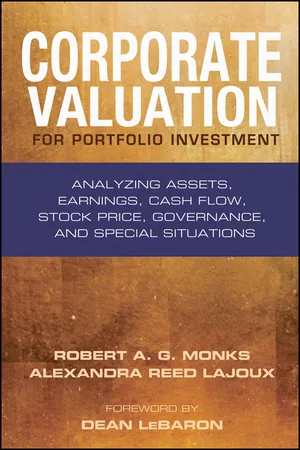Business
Stock Prices
Stock prices refer to the current market value of a company's shares of stock. They are determined by supply and demand in the stock market and can fluctuate based on various factors such as company performance, economic conditions, and investor sentiment. Investors and analysts closely monitor stock prices to make investment decisions and assess the overall health of the stock market.
Written by Perlego with AI-assistance
Related key terms
3 Key excerpts on "Stock Prices"
- eBook - ePub
The Financial System and the Economy
Principles of Money and Banking
- Maureen Burton, Bruce Brown(Authors)
- 2014(Publication Date)
- Routledge(Publisher)
The size of a shareholder’s ownership position depends on the number of stock shares owned. For example, if 1,000 shares are outstanding, a stockholder who owns 100 shares in effect owns 10 percent of the firm. The value of each share—and, therefore, the value of the stockholder’s holdings in the corporation—depends on the prevailing price of the firm’s stock. If, for example, the stock’s price is $50 per share, the total value of the stockholder’s 100 shares is $5,000, and the total value of the firm is $50,000 ($50 × 1,000 shares). If the stock price rises to $60 per share, then the value of the stockholder’s 100 shares increases to $6,000 and the value of the firm increases to $60,000. Likewise, given an unforeseen fall in the stock’s price to $40 per share, the values of the stockholder’s shares and the firm decrease to $4,000 and $40,000, respectively. The key question, then, is, What determines the price per share?Outstanding shares of stocks of publicly held companies are traded (bought and sold) on organized exchanges such as the New York Stock Exchange or by networks of brokers and dealers around the country. (More on this in Chapter 14 .) Stock Prices fluctuate daily, some going up, some going down, as financial investors buy and sell shares of various corporations. In part, those fluctuations occur because a share of stock represents a claim on the earnings of a firm. Tangible evidence of this sharing of earnings comes in the form of dividends, which are a distribution of profits to stockholders. If earnings prospects are improving, the share price and dividend paid per share may also be rising.2 Financial investors will be attracted by the improved outlook (profitability) for the firm.In general, as current and expected future earnings rise, Stock Prices also rise, and as current and prospective earnings decline, Stock Prices also decline. A growing economy means that sales, production, and incomes are expanding, while a declining economy means the opposite. Because expected earnings also rise when the economy is expected to grow and tend to fall when the economy is expected to contract, there is often a positive correlation between the growth of real national income and Stock Prices.3 - eBook - ePub
Corporate Valuation for Portfolio Investment
Analyzing Assets, Earnings, Cash Flow, Stock Price, Governance, and Special Situations
- Robert A. G. Monks, Alexandra Reed Lajoux(Authors)
- 2010(Publication Date)
- Bloomberg Press(Publisher)
CHAPTER 5Valuation Based on Securities PricesFinancial markets should not be treated as a physics laboratory but as a form of history.—George Soros, “Anatomy of a Crisis” April 9, 2010 (at King’s College, Cambridge)TO ESTIMATE THE VALUE of a company’s securities, investors can study its assets, earnings, and cash flow—the subjects of our opening chapters. But another indicator of securities’ value—a deceptively simpler one—is their current price: the dollars and cents that other investors are willing to pay for them right now on the open market. This chapter is for prospective investors who already know about a company’s financial statements but who want to glean information from current Stock Prices as well.It may seem obvious at best—and tautological at worst—to say that a security’s current price tells you something significant about its value. But in fact what does price, by itself, really tell you? It indicates only what other investors are willing to pay during the time of the price: it sets a temporary floor for buying today. A security’s price shows the market’s expectations about the company right now. The real question for investors is, what will the price be in the future when it’s time to sell? Thus price-based analysis anticipates price change from the moment of purchase to the moment of sale, whether one day or 30 years hence. This analysis varies according to the investor’s theory of stock market values.This chapter compares different stock market value theories and explains their relevance to different kinds of investors.Overview of Securities Prices
Public markets are the generally accepted mode for valuing securities, but the prices they set may miss the mark when it comes to true value. Lord John Maynard Keynes famously characterized the process of valuing publicly traded securities as a beauty contest. He noted that investors are highly intelligent people trying to guess what the average person thinks.1 And in 1993, Peter Drucker wrote to the senior author of this book:And one of the basic problems is that management has no way to judge by what criteria outside shareholders value and appraise performance—the stock market is surely the least reliable judge or, at best, only one judge and one that is subject to so many other influences that it is practically impossible to disentangle what, of the stock market appraisal, reflects the company’s performance and what reflects caprice, affects the whims of securities analysts, short-term fashions and the general level of the economy and of the market rather than the performance of a company itself.2 - eBook - ePub
- John Hampton(Author)
- 2011(Publication Date)
- AMACOM(Publisher)
Speculative firms . Some firms operate in markets where future success is not easily predicted. Examples are companies that are developing new products for high-technology markets and oil exploration firms. The value of these stocks depends upon factors that are not easily analyzed with intrinsic value techniques.• High-growth firms . A firm that is growing rapidly will generally be priced to reflect future expectations of rapidly growing sales and profits. The value of such firms is dependent upon a realization of the growth rate. Since rapid increases in sales and profits are difficult to sustain in most competitive environments, intrinsic value analysis is of limited help with high-growth firms.Current Market Value Analysis
A second major analytical tool for evaluating common stock considers the prices of individual stocks and compares them to other indicators of market value. Called current market value analysis , this approach deals with market prices, not intrinsic values. It considers short-term factors such as:• Overall market level . At certain times, common stock appears to be undervalued compared to bonds, other financial securities, real estate, or other investments. At such times, investors may seek to acquire a higher percentage of stock in their investment holdings. The logic is that stocks overall are undervalued. As soon as the market recognizes the disparity between stocks and other investments, Stock Prices will rise.• Industry comparisons . Stocks in the same industry may trade at widely different prices that do not appear to be based upon fundamental factors. An investor may seek to purchase the stock of a firm whose price is lagging behind that of other stocks in the industry. The rationale, once again, is that the market will discover the discrepancy and the stock price will rise.• Cyclical lows
Index pages curate the most relevant extracts from our library of academic textbooks. They’ve been created using an in-house natural language model (NLM), each adding context and meaning to key research topics.


